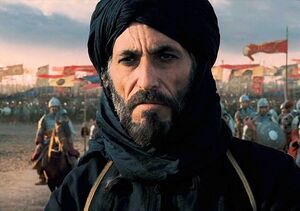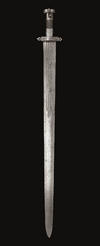Sultan Sayfuddin Ghazi
| Sayfuddin | |
|---|---|
| Sultan | |
 Sultan Sayfuddin Ghazi | |
| Reign | 1196 - 1223 |
| Successor | Badruddin |
| Born | 1159 Dabil, Mansuriyyah |
| Died | 1224 Ra's al-Arsal |
| Burial | Adra |
| Dynasty | Rawwadid Dynasty |
| Religion | Islam |
Al-Fatih Sayf al-Din Zahir ibn Khaled ibn Rawwad (Arabic: الفاتح سيف الدين زاهد بن خالد بن رواد), better known as Sayfuddin Ghazi, was a Muslim Kurd and the founder of the Rawwadid dynasty. Sayfuddin led the Muslim military campaign against the Makedonian Empire in northwestern Mansuriyyah. At the hight of his power, his sultanate spanned most of western, central and northern Mansuriyyah, consisting of much of today's provinces oh Hawram, Adnaniyyah, Maghrib and parts of Jazira and Ahsa.
Under Sayfuddin's command, the Rawwadid army defeated Zetes the Younger at the Battle of Tell Saqara, paving the way for the end of the Makedonian presence in Mansuriyyah. As Sultan, he also engaged in a combination of diplomacu and military action, allowing the Rawwadids to consolidate themselves and expand their empire.
Early life
He was born in 1159 in the town of Dabil, in modern-day Artaafat province in northeastern Mansuriyyah. His family belonged to the local minor aristocracy, holding some lands near the town. Sayfuddin’s father and an uncle moved to Hawram when he was 5 or 6 years old, in order to serve the Shuja’id Sultan. Sayfuddin spent most of his infancy in Adra, which according to his biographers he received a thorough education, learning the Quran and religious disciplines as well as mathematics, philosophy, poetry and military training. During his youth he showed more interest in his academic studies, reportedly planning to enter Shuja’id service as a bureaucrat or judge, but Shaykh Fakhruddin al-Nakkash, a Sufi master he was associated with in his earlier years, is said to have had a prophetic dream. He allegedly say Sayfuddin being carried out on the shoulders of a multitude, sword in hand, as he destroyed pagan idols. He interpreted it as a sign Sayfuddin would one day become a great leader, so he changed his plans and gave more emphasis to military instruction.
Ascension
At age 22 he participated in his first military campaign, and for the next decade he would fight in several conflicts, subduing parts of southern Hawram and western Jazira to his suzerain, as well as wrestling the cities of Ayntab and Riha from Makedonian hands. At age 30 he received lordship over the impressive Qalaat al-Muniah castle in northern Hawram. The fortress, located on a hill overlooking a vast plain which was located at a major route.
Reign
His lord, the Shuja’id sultan Numan, died in 1194 in the middle of a military campaign, shortly after capturing Ayntab and Riha. He was followed by his son Farfur, who was uninterested in continuing his father’s wars and sought peace with the Makedonians, signing a peace agreement which Sayfuddin considered humiliating, granting to the Makedonians much of the land they had liberated in the last years. Sayfuddin raised arms in revolt against Farfur, toppling him in 1196. He spent most part of the following decade consolidating and expanding his domains until he had most of the former Shuja’id territory under his control.
In 1206 he launched a military campaign against the Makedonian Empire, landing them a crushing defeat at the Battle of Tell Saqara. He wrestled control over modern-day northwestern Mansuriyyah in 1210, defeating an imperial army and permanently ending Makedonian lordship south of the Matra Mountains.
Later life and death
Being well-educated himself, during his reign Sayfuddin built and endowed several educational institutions. He built colleges of law and Sufi monasteries in several cities including Adra, Dayr Hafir and Afshar, as well as founding a great library in Adra, with an attached copying workshop for the production of books. He also ordered the construction of at least three hospitals and medical colleges. Sayfuddin is also considered an efficient administrator who took interest in building various infrastructure projects, such bridges, irrigation and shipping canals, improved harbors and created a mounted message relay system across his domains. He abdicated his position in 1223 in favor of his son Badruddin and spent the last few months of his life in seclusion at a Sufi monastery in the Qartaba Mountains. He was buried in a mausoleum in the garden inside the complex of a school he built in Adra, next to the city’s Great Mosque.

